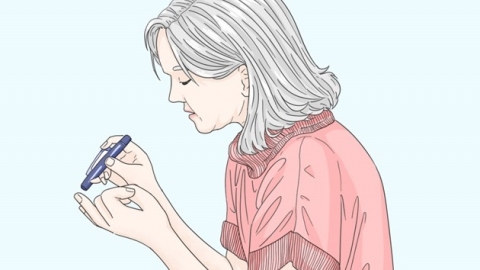Reasons for vision darkening in diabetic patients after prolonged squatting
Eye darkening after prolonged squatting in diabetic patients may be caused by orthostatic hypotension, hypoglycemia, anemia, retinopathy, arrhythmia, or other factors. Management should be based on specific situations. It is recommended to visit a hospital promptly and follow medical advice for treatment.

1. Orthostatic Hypotension: Sudden standing after prolonged squatting causes rapid postural change, preventing blood from reaching the brain in time, resulting in a temporary drop in blood pressure and insufficient cerebral blood supply. Symptoms include dizziness and eye darkening upon standing, which usually resolve quickly. Improvement methods include slowly rising after squatting to allow the body to adjust, and increasing salt intake and water consumption appropriately to enhance blood volume.
2. Hypoglycemia: Improper medication use, irregular eating habits, or excessive physical activity in diabetic patients may lead to hypoglycemia. When this occurs, the brain lacks sufficient energy supply, causing symptoms such as eye darkening, dizziness, palpitations, and sweating. Immediate consumption of sugary foods like candies or biscuits is recommended to rapidly raise blood glucose levels and alleviate symptoms.
3. Anemia: Long-term inadequate nutrient intake, chronic blood loss, kidney disease, or other factors in diabetic patients may lead to anemia, reducing the blood's oxygen-carrying capacity and causing brain hypoxia, which may result in eye darkening after prolonged squatting. Common accompanying symptoms include pale complexion and fatigue. Patients can take medications such as ferrous succinate tablets, vitamin B12 tablets, and folic acid tablets under medical guidance to improve symptoms.
4. Retinopathy: Long-term hyperglycemia damages retinal blood vessels, affecting retinal blood supply and visual function. Patients may experience vision loss, blurred vision, eye darkening, and other symptoms. It is recommended to use medications such as metformin hydrochloride tablets, calcium dobesilate capsules, and pancreatin enteric-coated tablets under medical guidance to promote recovery.
5. Arrhythmia: Diabetic patients are prone to cardiovascular complications such as arrhythmia, which can impair cardiac blood supply function and lead to insufficient cerebral blood supply, causing eye darkening, along with symptoms such as palpitations, chest tightness, and chest pain. Patients should take medications such as aspirin enteric-coated tablets, atorvastatin calcium tablets, and isosorbide mononitrate tablets as directed by a physician to alleviate symptoms.
In daily life, it is recommended to maintain good posture, follow a low-sugar diet, and engage in appropriate physical activity to promote overall health.
References:
[1] Xiao Hui, Wei Lin, Wen Liping. Analysis of the effectiveness of non-mydriatic fundus photography in screening for diabetic retinopathy [J]. The Physician, 2025, 10(06): 123-125.
[2] Zhou Shun, Wang Yan, Leng Jing, et al. Current status of proteomic studies on diabetic retinopathy [J]. International Journal of Ophthalmology, 2025, 25(03): 428-433.
[3] Yang Gang, Huang Bohao, Zhang Wei, et al. Observation of the efficacy of iron sucrose combined with Baoling Capsules in treating anemia in patients with diabetic nephropathy undergoing hemodialysis [C]//Chongqing Health Promotion and Education Association. Proceedings of the Academic Symposium on Clinical Medicine, Health and Communication (Volume I). The Fifth Hospital of Baoding City; 2025: 587-590.







